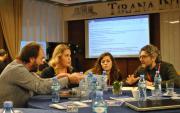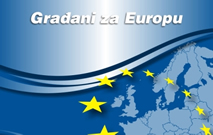To share or not to share? Fusion it!
 Nuclear fusion, in physics, is a process in which two or more atomic nuclei come close enough to form one heavier atomic nucleus. In communication, fusion is also a process in which more representatives of civil society organisations are merging to form a quality communication nucleus of civil society. It is accompanied by sharing experiences and connecting ideas in a unique, future work frame, which depends on the motivation and commitment of the work of civil society organisations (CSOs).
Nuclear fusion, in physics, is a process in which two or more atomic nuclei come close enough to form one heavier atomic nucleus. In communication, fusion is also a process in which more representatives of civil society organisations are merging to form a quality communication nucleus of civil society. It is accompanied by sharing experiences and connecting ideas in a unique, future work frame, which depends on the motivation and commitment of the work of civil society organisations (CSOs).
Placing the media, CSOs and communication in one context is part of a natural process, but more commonly it is not that simple.
Nowadays, CSOs that contribute to community development in any way (referred throughout the article as we) are in an era of very important tools to which we contribute the development of our local communities and even the countries that we live in. CSOs and the media are initiating and creating important aspects and processes of development, dialogue and changes in our countries. The moment when this opportunity becomes a challenge for CSOs – is when all of the work needs to be communicated and directed through the appropriate communication channels, resulting in communication confusion, lack of direction, tools and motivation. While we know what all of that looks like, we still strongly believe that the final outcome can be good and positive.
Last week, communication fusion, organised by the Technical Assistance for Civil Society Organisations (TACSO) Project, showed good examples and possible solutions for some of the dilemmas we identified as challenges in CSOs’ communication, but also within communication between CSOs and the media. The two-day regional workshop: Communication Fusion for CSOs was the right strategic gathering to create an on the spot human platform for exchanging information and the experiences of CSOs and the media. The workshop offered new knowledge and ideas for effective improvement of offline and online communication. Impressive guest speakers, each with their own presentation, opened new and interesting areas of communication.
The first day of the workshop was marked by lessons learned in the area of relations between the media and CSOs; internal communication; typical behaviours in the communication process; community relations building; and how CSOs can present their work to the public. Working in groups, in some cases with elements of case studies, was a good way for the participants to define a specific problem or situation and apply the current work methods to the problem. Therefore, on the first day, we summarised all that we are using now on a daily basis in communication and work. A clear transition was seen of the participants’ understanding of the challenges from one frame to a completely new framework that is adapted to the current trends and needs of those with whom we communicate and to whom we send messages.
The second day represented a natural extension of new media and storytelling components that helped the workshop come full circle in offering concrete guidelines for CSOs and their online communication. Work in groups and on concrete examples such as developing a communication plan for social media, and designing a clear campaign (with only a picture or with only six words in a slogan) showed the participants how much we (do not) know how to communicate in certain situations. Questions that arose included: what are the necessary competencies; how much time do we need; how many people; and why communication can be critical for the development of a CSO.
If you are a CSO that only has a Facebook profile and you are still not satisfied with your presence on social media, then you definitely need to think seriously about opening accounts on other social media channels such as Instagram, Twitter, maybe even Pinterest – of course, depending on your target group. But then again, communicating on these platforms can help you define your target group. It is known that delegates across Europe lobby their votes among the youth population via Snapchat. So, everyone is already there, the question is when are you going to join? But that is not all, what could make you more visible and notable for your partners and beneficiaries is the content you create and offer. How and in which way are you telling your story and how different you are could distinguish you from the line of organisations which are working on the same issues as you. It is no longer a question of “did you publish the information about the partnership with the respectable ministry” but “where did you post it and is there a photo on Instagram?” Two-way communication on social media is a benefit for CSOs, because with a simple click we can distribute a survey about the needs of civil society or find out how much support we have in an initiative of proposed amendments to a certain law.
Communication has always been an essential, but also the most sensitive part of the work of CSOs. The message about CSOs’ work has to be understandable not only to our government partner and participants but also to the wider public. The speed at which messages can reach a huge number of users/followers is still fairly significant. Therefore, the presence on social media is extremely important if by that we do want to build a constant or brand. To communicate the content in a simple way and at the same time to stay true to the project language and tasks is one of the biggest challenges for CSOs. During the workshop we addressed and discussed these issues with experts and colleagues from other CSOs and the media; among the other reasons why this workshop was a great stage with a good sound system and even better voices of experience and ideas.
In physics, to create fusion it is necessary to overcome a considerable energy barrier.
In communication, to lead to fusion you have to overcome resistance to change, lack of knowledge and you need to know your own communication channels.


